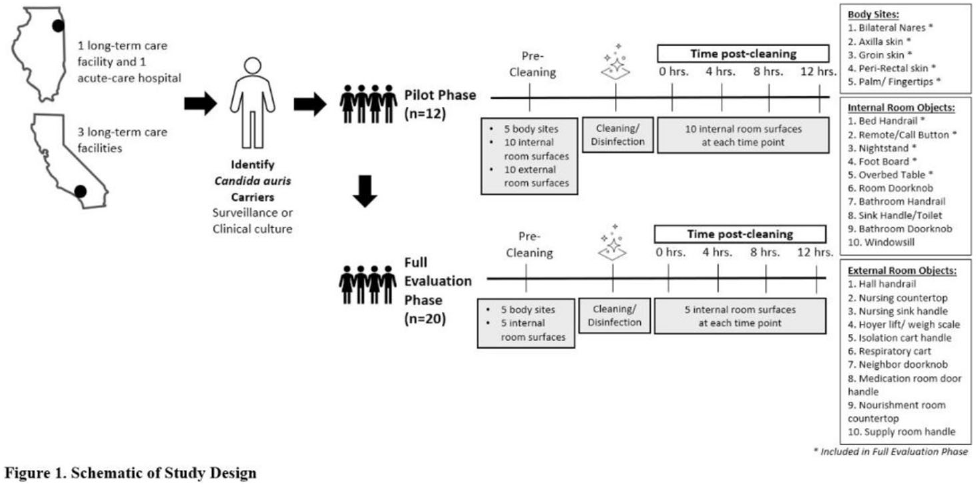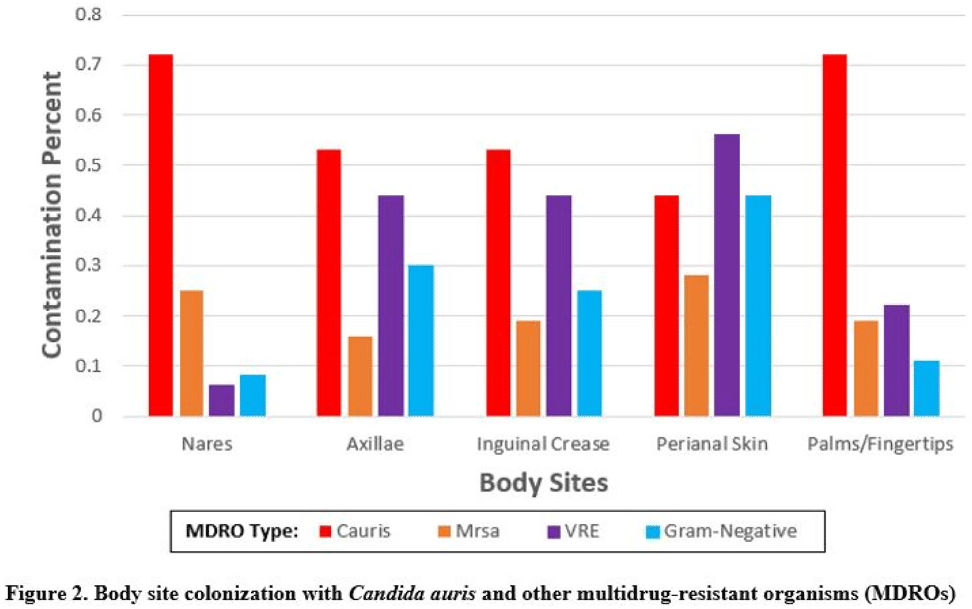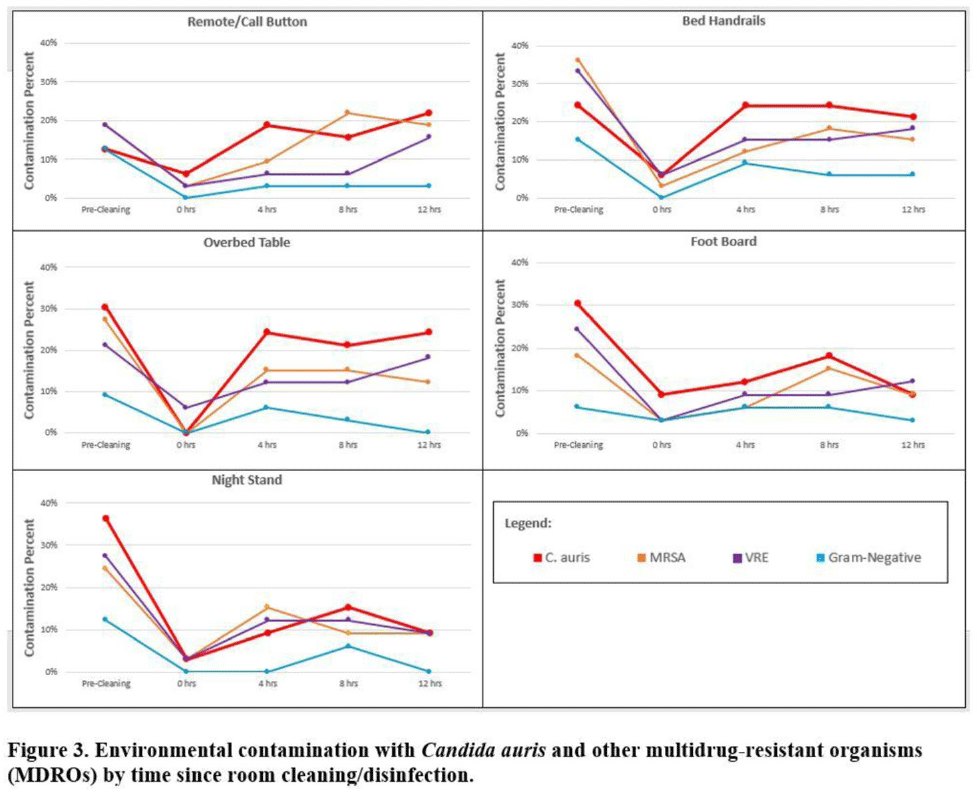14 results
Multicenter evaluation of contamination of the healthcare environment near patients with Candida auris skin colonization – ERRATUM
-
- Journal:
- Antimicrobial Stewardship & Healthcare Epidemiology / Volume 2 / Issue 1 / 2022
- Published online by Cambridge University Press:
- 07 October 2022, e166
-
- Article
-
- You have access
- Open access
- HTML
- Export citation
Outbreak investigation of CRAB at an acute-care hospital ICU during the COVID-19 pandemic–Chicago, Illinois, March 2020–September 2021
-
- Journal:
- Antimicrobial Stewardship & Healthcare Epidemiology / Volume 2 / Issue S1 / July 2022
- Published online by Cambridge University Press:
- 16 May 2022, p. s84
-
- Article
-
- You have access
- Open access
- Export citation
Multicenter evaluation of contamination of the healthcare environment near patients with Candida auris skin colonization
-
- Journal:
- Antimicrobial Stewardship & Healthcare Epidemiology / Volume 2 / Issue S1 / July 2022
- Published online by Cambridge University Press:
- 16 May 2022, pp. s78-s79
-
- Article
-
- You have access
- Open access
- Export citation
Regional Impact of a CRE Intervention Targeting High Risk Postacute Care Facilities (Chicago PROTECT)
-
- Journal:
- Infection Control & Hospital Epidemiology / Volume 41 / Issue S1 / October 2020
- Published online by Cambridge University Press:
- 02 November 2020, pp. s48-s49
- Print publication:
- October 2020
-
- Article
-
- You have access
- Export citation
Repeated Prevalence Surveys and Admission Screening for Candida auris at One Long-Term Acute-Care Hospital, Chicago, 2016–2019
-
- Journal:
- Infection Control & Hospital Epidemiology / Volume 41 / Issue S1 / October 2020
- Published online by Cambridge University Press:
- 02 November 2020, pp. s14-s15
- Print publication:
- October 2020
-
- Article
-
- You have access
- Export citation
Candida auris and Carbapenemase-Producing Organism Prevalence in an Extended Stay Pediatric Hospital, Chicago, Illinois, 2019
-
- Journal:
- Infection Control & Hospital Epidemiology / Volume 41 / Issue S1 / October 2020
- Published online by Cambridge University Press:
- 02 November 2020, pp. s145-s146
- Print publication:
- October 2020
-
- Article
-
- You have access
- Export citation
9 - Supply Chain Management and Native American Entrepreneurs
- from Part III - Learning from Business Scholars
-
-
- Book:
- Creating Private Sector Economies in Native America
- Published online:
- 15 October 2019
- Print publication:
- 24 October 2019, pp 170-184
-
- Chapter
- Export citation
Sustainability and public health nutrition at school: assessing the integration of healthy and environmentally sustainable food initiatives in Vancouver schools
-
- Journal:
- Public Health Nutrition / Volume 18 / Issue 13 / September 2015
- Published online by Cambridge University Press:
- 16 March 2015, pp. 2379-2391
-
- Article
-
- You have access
- HTML
- Export citation
Regional Infection Control Assessment of Antibiotic Resistance Knowledge and Practice
-
- Journal:
- Infection Control & Hospital Epidemiology / Volume 36 / Issue 4 / April 2015
- Published online by Cambridge University Press:
- 13 January 2015, pp. 381-386
- Print publication:
- April 2015
-
- Article
- Export citation
14 - Culture and Community in a Virtual World for Young Children
-
-
- Book:
- Games, Learning, and Society
- Published online:
- 05 August 2012
- Print publication:
- 11 June 2012, pp 210-228
-
- Chapter
- Export citation
Identification, Management, and Clinical Characteristics of Hospitalized Patients with Influenza-Like Illness during the 2009 H1N1 Influenza Pandemic, Cook County, Illinois
-
- Journal:
- Infection Control & Hospital Epidemiology / Volume 32 / Issue 10 / October 2011
- Published online by Cambridge University Press:
- 02 January 2015, pp. 998-1002
- Print publication:
- October 2011
-
- Article
- Export citation
Clostridium difficile Outbreak Strain BI Is Highly Endemic in Chicago Area Hospitals
-
- Journal:
- Infection Control & Hospital Epidemiology / Volume 32 / Issue 9 / September 2011
- Published online by Cambridge University Press:
- 02 January 2015, pp. 897-902
- Print publication:
- September 2011
-
- Article
- Export citation
Investigation of an Outbreak of 2009 Pandemic Influenza A Virus (H1N1) Infections among Healthcare Personnel in a Chicago Hospital
-
- Journal:
- Infection Control & Hospital Epidemiology / Volume 32 / Issue 6 / June 2011
- Published online by Cambridge University Press:
- 02 January 2015, pp. 611-615
- Print publication:
- June 2011
-
- Article
- Export citation
“In the Power of God Christ”: Greek inscriptional evidence for the anti-Arian theology of Ethiopia's first Christian king
-
- Journal:
- Bulletin of the School of Oriental and African Studies / Volume 71 / Issue 1 / February 2008
- Published online by Cambridge University Press:
- 20 February 2008, pp. 93-110
- Print publication:
- February 2008
-
- Article
- Export citation





